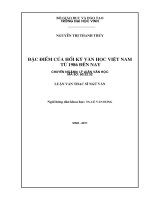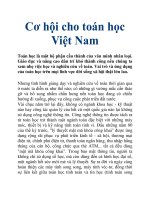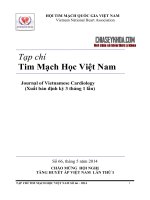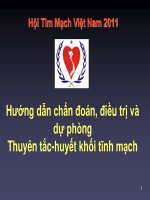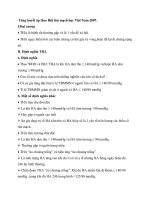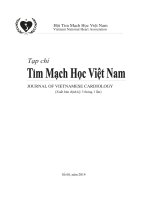Hội Tim mạch học Việt Nam
Bạn đang xem bản rút gọn của tài liệu. Xem và tải ngay bản đầy đủ của tài liệu tại đây (18.5 MB, 36 trang )
Some points updated on
myocarditis
Nguyen Ngoc Quang, MD, FASCC
Dept. of Cardiology, Hanoi Medical University
Vietnam National Heart Institute
1. Epidemiology
✓ True incidence of myocarditis in community is unknown
✓ Greatest burden of myocarditis (chronic DCM, then die
or require orthotopic heart transplantation) may not be
apparent for 6-12 years after diagnosis
50
Underlying Causes and Long-Term Survival in Patients with Initially
Unexplained Cardiomyopathy.
Felker GM, et al. N Engl J Med 2000; 342:1077-1084
9
IDCM
Myocarditis
7
Ischemic
5
4
4
4
3
3
Infiltrative
Peripartum
HTN
HIV
CTD
Abuse
A
B
C
Symptom threshold
Active
myocarditis
Left ventricular
function
Normal
Poor
Clinical
syndrome of
heart failure
Severe
Normal
Time
Years
In Review, Lancet, 2009
2. Etiology
✓ Viral & postviral myocarditis: major causes of acute and chronic
dilated cardiomyopathy
✓ Spectrum of viruses (EMB samples) shifted from coxsackievirus B to adenovirus to parvovirus B19 and other viruses.
✓ Less frequent viruses: hepatitis C, EBV, CMV and HIV.
Coxsackie B
Coxsackie A
1948
Other
Many
Adenovirus
Enterovirus Uncommon
HCV
Viruses
Enteroviruses
HHV6
EBV
PVB19
2010
Non-Enteroviruses
Many injuries can cause
myocarditis
•
•
•
•
•
•
•
Viruses- changing spectrum
Toxins- Doxorubicin
Radiation
Hypersensitivity Reactions
Drugs, Vaccines
Bacterial, fungal, protozoal Infections
Genetic predisposition in 20% or more
Some special etiology
✓ Hypersensitivity myocarditis: anticonvulsants,
antibiotics, and antipsychotics.
✓Eosinophilic myocarditis: Churg–Strauss syndrome,
Loffler’sendomyocardial fibrosis, cancer, and parasitic,
helminthic, or protozoal infections and with vaccination
for several diseases, including smallpox.
✓ Giant-cell myocarditis (acute dilated
cardiomyopathy): thymoma, autoimmune disorders,
ventricular tachycardia, or high-grade heart block.
Major causes of myocarditis
✓ Infectious causes ✓ Noninfectious causes
✓ Viral
✓ Cardiotoxins:
✓ Bacterial
✓Catecholamines, Anthracyclines, Cyclophosphamide,
✓ Spirochetal
Heavy metals (copper, lead, iron), Arsenic,
✓
✓ Mycotic
✓ Alcohol, Cocaine, Carbon monoxide,Methysergide
✓ Rickettsial
✓ Hypersensitivity reactions:
✓ Protozoal
✓ Helminthic
✓ Antibiotics, Diuretics, Dobutamine; Lithium; Tetanus toxoid;
Clozapine; Methyldopa
✓ Insect bites (bee, wasp, spider, scorpion, Snake)
✓ Systemic disorders
✓ Collagen-vascular diseases, Sarcoidosis, Celiac disease,
Kawasaki disease, Hypereosinophilia, Wegener's granulomatosis,
Thyrotoxicosis
✓ Inflammatory bowel disease (Crohn's disease, ulcerative colitis)
✓ Radiation
3. Pathophysiology
Progression from acute injury to chronic DCM: 3-stage process:
✓ Acute injury leads to cardiac damage (myocyte death)
within hours of viral cell entry, results from direct viral damage
tomyocytes
✓
Exposure of intracellular antigens (cardiac myosin) and an
innate immune response comprised of altered regulatory T cell
function, NK cells, interferon gamma, nitric oxide…
✓ Heart specific immune response characterized by antibodies
to pathogen, host cardiac proteins and autoreactive T cells.
Most recover with few consequences, a minority die from
arrhythmias or progress onto chronic HF
Immune Pathogenesis
of Chronic DCM
Acute Myocarditis
Innate Immunity/TLRs
Anti-viral response
Cytokines (TH1/TH2/TH17)
Autoimmunity
T and B cell Mimicry
Recognition of Myosin
by Immune System
Chronic Myocarditis
Autoreactive
T cells and Autoantibodies
Antibody Mediated
Cell Signaling in the Heart
Relapsing and Remitting
Autoimmunity
Epitope Spreading
Dilated Cardiomyopathy
Pathogenesis of DCM After Enteroviral Infection
Coxsackie B virus
Myocyte infection
Days
“Normal heart”
Necrosis
Apoptosis
Innate immunity
Myocyte cytoskeletal damage
Direct cytopathic effect
Myocyte cell death
Weeks
• Autoantibodies
• Autoreactive
• T lymphocytes
?
Acute dilated
cardiomyopathy
Months
to years
Sequestered
viral genome
Hemodynamic
remodeling
Neurohumoral
activation
Cooper LT, Gersh BJ. Am J Card, 2002
Apoptosis
Chronic dilated cardiomyopathy
CP1184045-6
4. Clinical Presentations
✓ Viral prodrome and highly variable symptoms
✓ Children often have fulminant presentation.
✓ Common clinical presentation
✓ Acute Heart Failure with Dilated Cardiomyopathy
✓ Syncope: poor prognosis if related with VT or AVB
✓ Fulminant heart failure after viral syndrome:
better prognosis but require hemodynamic support
✓ Chest pain: good prognosis
5. Diagnostic procedures
✓ Troponin I: specificity 89%, sensitivity 34%
✓ ECG: sensitivity: 47%
✓ Endomyocardial biopsy
✓ Echocardiography: to distinguished fulminant myocarditis
✓ Cardiovascular magnetic resonance
✓ Analysis of messenger RNA and protein markers
✓...
US Centers for Disease Control
Case Definitions for Myocarditis
• Possible- Clinical syndrome with typical EKG
changes, and troponin rise or abnormalities on
echocardiogram
• Probable- Criteria for possinle myocarditis and
NEW changes on echocardiogram
• Confirmed- Positive histology
MMWR 2003
Typical Electrocardiogram
Acute Myocarditis
I
aVR
V1
V4
II
aVL
V2
V5
III
aVF
V3
V6
Sensitivity ~42%
Morgera 1992
2:1 Second degree HB and Q waves
In Acute Myocarditis
Nakashima 1998
Comparison of the Sensitivity and Specificity of
Troponin and Heart Biopsy for Myocarditis
Specificity
(%)
Positive
predictive
value
Negative
predictive
value
Technique
No.
Sensitivity
(%)
Troponin T
80
53
96
93
56
Troponin I
88
34
89
–
–
EMB-H and E
71
10-36
98
–
–
EMB-Immunoperoxidase
20
80
85
–
–
Skouri et al: JACC 48(10):2085, 2006
CP1256539-1
Endomyocardial Biopsy
EMB Indication (Class I, LOE B)
• New onset heart failure
• of 2 weeks to 3 months duration
• assoct. w a dilated left ventricle,
• new ventricular arrhythmias,
• 2nd or 3rd degree heart block
• failure respond to usual care
within 1 to 2 weeks
Cooper, LT, et al Circulation 2007
Histologic “Dallas” Criteria
Sampling error, Variation in interpretation, Low
sensitivity, Lack of correlation with outcome
Aertz, et al Am J Pathol 1986
Baughman, K, Circulation 2006
Endomyocardial Biopsy
Giant Cell Myocarditis
When to Suspect Giant Cell
Myocarditis
• Failure to Respond to Usual
Care
• Ventricular Tachycardia
• High-grade Heart Block
Cooper, LT, et al AHJ Dec 2008
Giant Cell versus Lymphocytic Myocarditis
Transplant-Free Survival
Proportion surviving
1.0
LM group
GCM group
0.8
0.6
0.4
0.2
0
0
1
2
3
Survival (yr)
4
5
Cooper, LT, NEJM 1997
Death or Transplant
P=0.0005
Event free of death
or transplant
1.0
Trial
0.8
0.6
0.4
0.2
Control
0
0
100
200
300
400
Days
Cooper, LT, et al Am Heart Journal 2008
Consensus Criteria on the CMR
Diagnosis of Myocarditis
Endorsed by SCMR
Myocardial Inflammation Requires 2 of 3
1. IR prepared T2 weighted images (body coil),
the regional or global intensity ratio of myocardium
to skeletal muscle exceeds 2SD (1.9)
2. T1 global enhancement ratio is greater than 2SD (4.5)
3. T1 “Late enhancement” post-contrast has
at least one focal lesion with
non-ischemic distribution
Friedrich, M., Presented ESC September 2008, JACC 2009
CMR in Acute Myocarditis
Triple-inversion-recovery
T2 weighted Spin echo CMR
T1 weighted fast spin echo
T1 inversion recovery
Skouri et al: JACC 48(10):2085, 2006
Antimyosin and Gallium Imaging in
Rheumatic Carditis
Indium-111
Antimyosin
Aschoff Nodule, 10x, 40x
Gallium-67
Enteroviral Infection & Clinical Outcome
Mortality in Myocarditis/
DCM Patients (%)
Proportion Surviving
Enterovirus
negative
1.0
1.0
0.9
0.9
0.8
0.8
0.7
0.7
0.6
0.6
0.5
25
25
20
P=0.02
P=0.02
15
10
Enterovirus
positive
5
4
0
0
4
8
12
16
20
24
28
Enteroviral RNA+
Enteroviral RNA-
Months
Detection of enteroviral RNA in pt with myocardial
disease is associated with an adverse prognosis and
is an independent predictor of outcome
Why HJ: Circ, 1994
Terasaki F: J Card Surg, 1999
